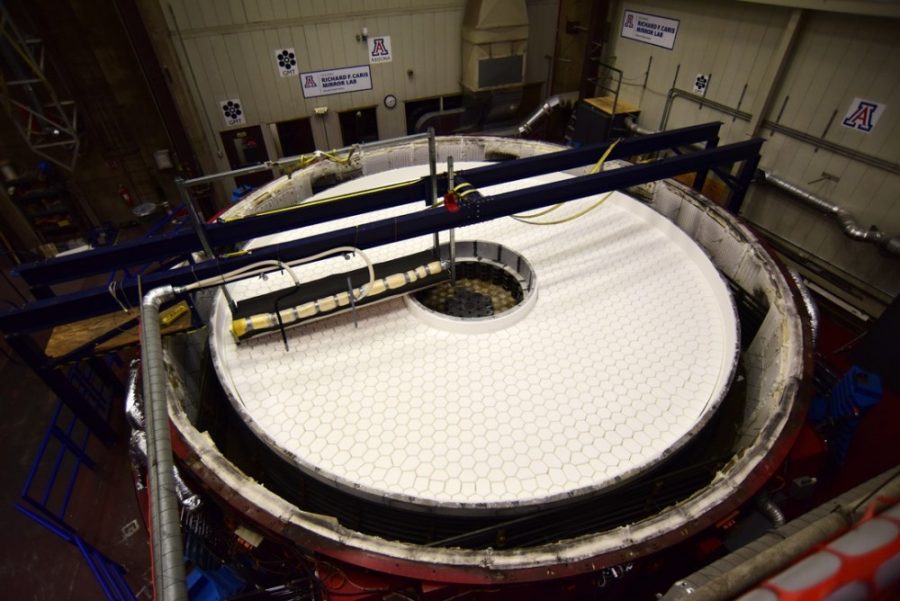While tailgates, parties, parades and bonfires might be the events most famously associated with Homecoming at the University of Arizona, there is a myriad of events for people looking for a quieter, more scholarly experience.
Among the non-sports-related events, the Class of 1969 will celebrate their reunion this Homecoming.
RELATED: OSIRIS-REx spacecraft getting closer to collecting asteroid samples
fter all, their year of graduation was also the year of the Apollo 11 moon landing.
The UA Libraries, Special Collections have put together an exhibit commemorating this event. The exhibit explores the history of moon-related findings and discoveries along with discoveries exclusive to scientists at the UA.
“The moon exhibit focuses on the story of moon mapping, especially of the lunar mapping that happened during the ’60s when [the] Lunar and Planetary Laboratory was established,” said Molly Stothert-Maurer, archivist and history of science curator.
She will be leading a 15-minute mini-tour of the exhibit on Nov. 1 at 9 a.m. and 3 p.m. About 10 people have registered for the tour in the morning and 10 for the afternoon, according to Stothert-Maurer, as of Oct. 23.
“The star of the show is something called a precision hemisphere,” Stothert-Maurer said. “It’s a large half-moon shape. In the early ’60s, Kuiper and his team projected the best telescope-based photographs of the moon onto the surface to correct for the curvature that happens when you take a picture of a round object and print it on a flat piece of paper.”
In the exhibit, a button can be pushed to illuminate this precision hemisphere with the rocky and crater-infested surface of the moon. Viewers can then look into a book to see the difference between the size of craters on the hemisphere from the ones on the page.
The exhibit includes works by Nicolaus Copernicus, Ptolemy and Gerard Kuiper, who is the founder of the Lunar and Planetary Laboratory.
On that same Friday, Nov. 1, the Richard F. Caris Mirror Lab will be giving tours at 10 a.m., 11 a.m. and 1 p.m. The tours last about an hour and explore the creation of gigantic telescope mirrors.
“On our tours, you will have the opportunity to witness first hand the process that is constructing these enormous mirrors,” Vannessa Gressieux, program coordinator at the mirror lab, said in an email.
“First, you will be given a presentation by our expert docents and student leaders, who have backgrounds ranging from optical sciences to astrophysics,” Gressieux said in the email. “After you have a better understanding of the science behind the construction of the mirrors, you will be taken into the lab where you will see the process that goes on. You will likely see multiple mirrors on one tour, whether the mirror is just coming out of the oven, or on the polishing table.”
Gressieux explained the importance of the tour and what the public can get out of the venture.
“After attending the tour, we hope that our guests walk away with a better understanding of how technology and innovation are allowing us to reach beyond the limitations that come with astronomy and telescope viewing,” Gressieux said in the email. “We hope they understand that technology is a tool that can be used to not only help us understand the universe better but maybe even help us find out what our place in the universe is.”
On Saturday, Nov. 2, the UA Libraries will host a breakfast that will go into details about renovations within the Main Library as well as the Albert B. Weaver Science-Engineering Library. This new space will be called CATalyst Studios and is intended to be a space for learning about new technologies.
Also on Saturday, at 11 a.m., the Flandrau Science Center will be hosting a lecture called “Space is Wildcat Country” to show how the UA has become a leader in astronomy. Admission is $5. Flandrau is also hosting other exhibits and presentations for $5 admission each.
UA Homecoming surely has enough events to ensure that any scientifically-interested minds will not be left out.
Follow Noah Cullen on Twitter















